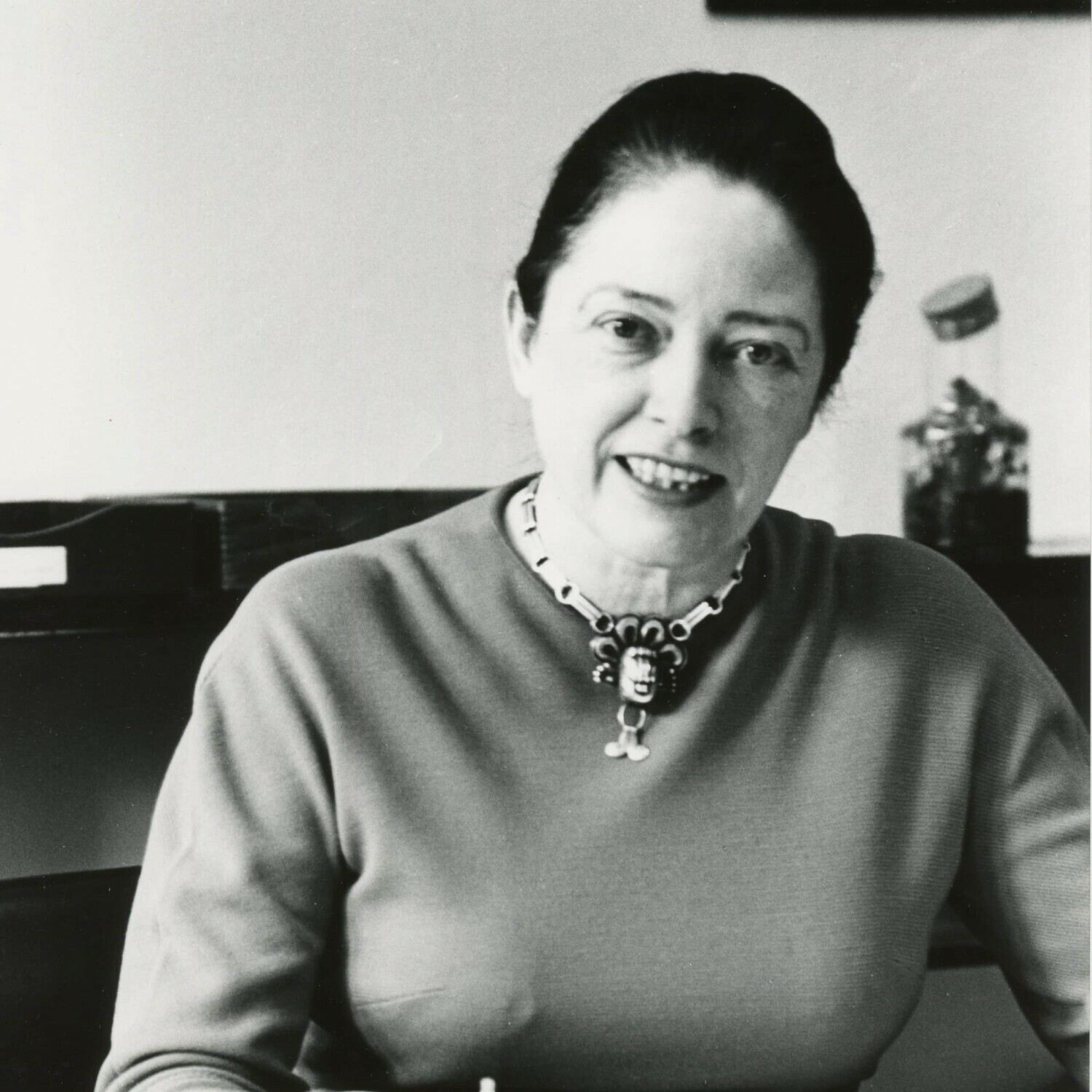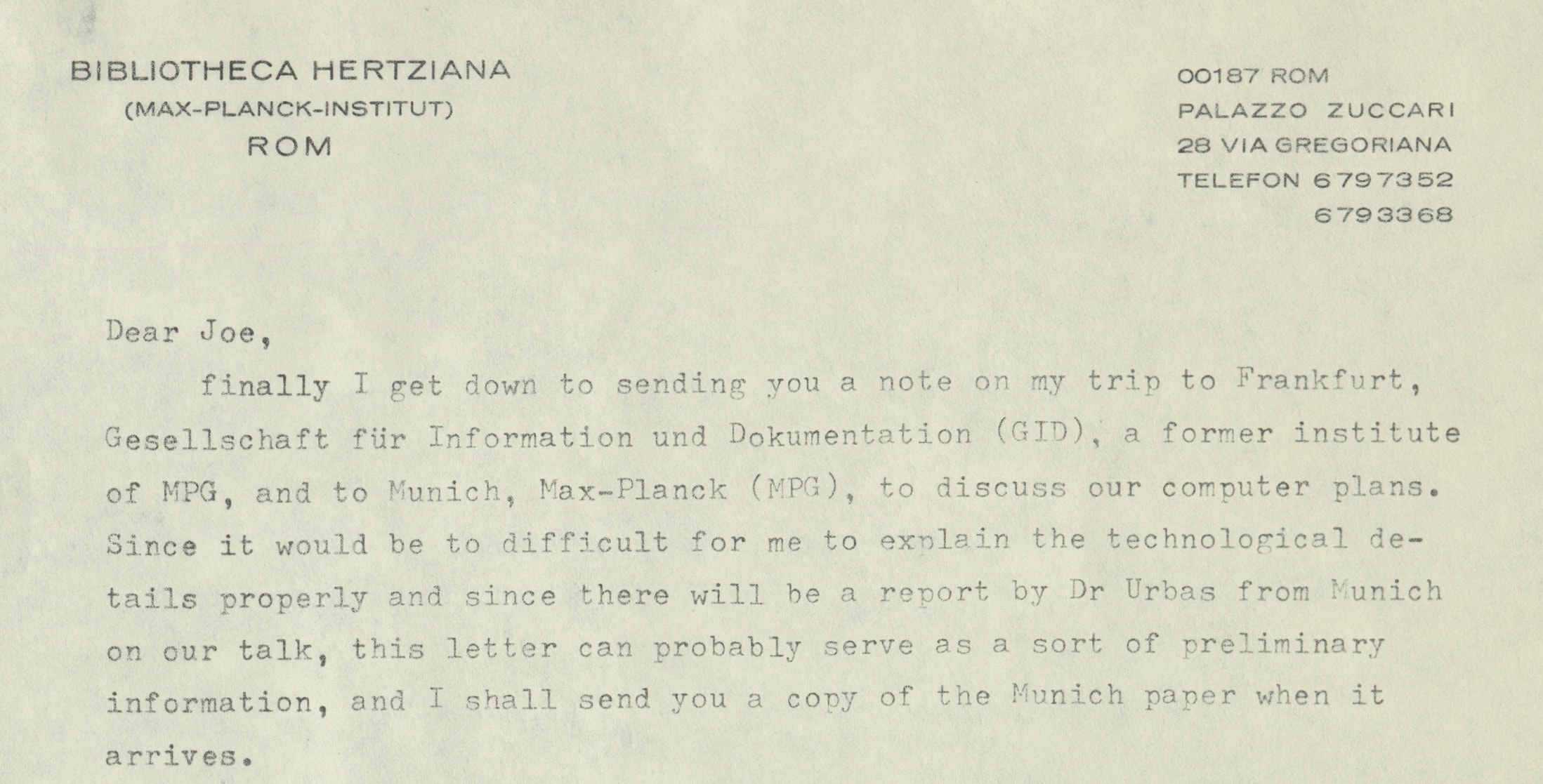Phyllis Bober and the Census Digitisation
In the late 1970s and early 1980s, the Census entered a new phase of its history. The art historian Michael Greenhalgh of Leicester University, a pioneer in the field of humanities computing, suggested that the Census be digitised, and began to gather support for such a project. At the same time, the possible utility of a digitised Census became clearer when the Biblioteca Hertziana, then directed by Christoph Frommel and Matthias Winner, became a partner institution and expanded the scope of the project to include architectural material. Together the Warburg and Hertziana won support for the computerisation of the Census from the Art History Information Program, a new initiative of the J. Paul Getty Foundation. In 1982, with financial assistance from the Getty and under the direction of Arnold Nesselrath, digitisation was underway. The database would continue to evolve over the following decades, as is described in Room 4.
In putting together this exhibition, seminar students conducted research into the letters kept in the archive of Phyllis Bober in the Bryn Mawr Special Collections. There, they found a number of interesting letters from the early 1980s which reveal Bober’s role in the computerisation of the Census.
Since 1946, Bober had directed the project and built the analogue Census. The decades-old Census project was embarking upon one of the first experiments in the history of what is now known as ‘digital humanities’. How would Phyllis Bober confront the situation?

Phyllis Pray Bober, Bryn Mawr Library Special Collections
The Bober Archive in Bryn Mawr
Today, most of Phyllis Bober’s papers are kept in the archives of Bryn Mawr College. Among these are personal letters and other materials, including index cards made for the Census, as well as numerous letters from Ruth Rubinstein discussing the Handbook and other matters.
This room highlights a number of letters Bober wrote to Joe Trapp, Director of the Warburg Institute, and to Nancy Englander at the Getty concerning the digitisation of the Census. Key quotations from her letters are given below.

Bryn Mawr Special Collections, Letter from Phyllis Bober to Joe Trapp (detail), 31 May, 1982
Phyllis Bober, Letters, 1982–3, Bryn Mawr Special Collections
Finally I get down to sending you a note on my trip to Frankfurt, Gesellschaft für Information und Dokumentation (GID), a former institute of MPG, and to Munich, Max-Planck (MPG), to discuss our computer plans […]
At first I got the impression that the people I talked to liked the project and that they did not see any major basic problem. At the moment there are two main questions to solve: The first is which machines we want to use […] the second question was concerned with the programming.
[…] I was asked also a few minor questions; e.g. they said in Frankfurt, we had to take into consideration when we start programming, whether and, if so, how we wanted to distribute our material (publication or on-line system). I can understand more clearly the work of writing a good thesaurus, something that was always obvious, but I can see better the work which will be required.
Letter to Joe Trapp, 31.5.1982
[Regarding the programming language of the computerised Census, Michael Greenhalgh] recommends Pascal; I know none, but understand that Basic (which might be easier for non-initiated users?) is less flexible and Fortran really designed for hi-speed math work. LISP, Pl‑1 or Pascal or???—anything so long as it is a language regularly taught in academic institution’s free course for faculty. […] If Pascal is easy to acquire, fine. This is an important point because I think it important that any on-line users be able to make up their own program to use the data base in new searches we might not have anticipated.
Letter to Joe Trapp, 26.8.1982
Apologies for computer illiteracy and, in the back of my mind, the still nagging memory of Warburgian antipathy for data retrieval and what in the 40’s was termed ‘the spectre of the i.e. Princeton Index of Christian Art’. It arises from my disquiet about modern intellectual and educational life; we seem more and more to resemble latter-day Romans cataloguing, making encyclopedias, retreiving and preserving atomized knowledge rather than seeking synthesis and basic research expanding into new realms of thought. I will be reconcilied only if we make this project a tool for constructive work i.e. in-put might include undocumented ‘possibles’ both from the history of museums and collections as well as unidentified drawings and literary descriptions, inventories (?? And this should somehow be made valuable to archaeologists in re restoration, earlier interpretations of given works, find-spots, etc.
Letter to Joe Trapp, 26.8.1982
Does on-line as projected mean only direct query at Warburg and Hertziana? Is it visualised for satellite or telephone access from other locations or will those abroad simply be served by up-dated print-outs and staff answers to letters? Has anyone considered costs in the former case? and charges? […] My mental picture was of two (or, indeed, four) micros both Warburg & Hertziana, compatibly speaking to each other and each Institute considered a central location for editing and change, Warburg figurative, Hertziana architectural, no matter how many other machines might be tuned in on compatible discs somewhere (foreshadowing future too immediately, perhaps).
Letter to Joe Trapp, 26.8.1982
[Describing a discussion at the Warburg Institute about the Census computer project]
The general topic of upgrading the graphics; queries about ways to permit comparison of drawings with ancient monuments or other pairings of images impossible to achieve in analog; enormous costs of laser video-discs that might help in solving problems we foresee in light of most users preferring image rather than text access to the data base in the first instance; and storage problems. Above all, problems of reproduction rights on photographic copyrights. Since I chair the art historians’ committee of the College Art Association Board of Directors and we are presently addressing the issue of vastly increased reproduction fees that are hampering scholarship, I was particularly interested in his question, an important one if we contemplate 108,00 [sic] to 150,000 images on video-disc. […] Networking, aside from the Hertziana connection; compatability with the British academic network and the Science Research Council. This service is free to academic users in Britain, but some question was raised about who charges and receives fees for Census users at some geographical distance or working from a satellite (?).
Letter to Nancy Englander, 19.6.1983
[Describing a discussion at the Warburg Institute about the Census computer project]
I was relieved to find that no adaptation will be included in the data base, so that my worries about “pollution” of the Census were shown to be groundless.
Letter to Nancy Englander, 19.6.1983
In the early 1980s, Bober wrote several letters to Joe Trapp relating her insights from discussions she had with various stakeholders of the digitisation process and her own acquaintances regarding the hardware, software and programming of the computer database. She travelled to the Gesellschaft für Information und Dokumentation in Frankfurt and the Max-Planck-Gesellschaft in Munich as a representative of the Census. In a letter to Trapp of May 1982, she summarised the results of the two meetings, which were focused on questions of hardware and programming. The letter reveals that Bober played an active role in lobbying for the digitisation of the Census, dealing not only with potential collaborators but also with technical issues.
A recurring theme in all of her letters from this time is a self-perceived lack of technical knowledge. She called herself ‘computer-illiterate’ or a ‘technopeasant’. While this could give the impression that she was unwilling or unable to contribute to the Census’s next, digital phase, the letters prove this not to be the case. She was not afraid of the digital future, but was at the time uncertain about what digitisation would look like. Her letters address concerns that are still familiar today: the cost of photographic reproductions, storage problems, and the question of how users will access the database. Long before the era of the internet, Bober imagined that access to the computers in London and Rome might be achieved by satellite, or by telephone. Search results might, she imagined, be printed out from the computers and then mailed to researchers. Publication seemed at this stage a more certain method of disseminating the results of the Census project, and was achieved in the handbook she published with Ruth Rubinstein, Renaissance Artists and Antique Sculpture (published in 1986).
The letters also reveal Bober’s concerns about what the digitisation of the Census cards will do to the value of the project. Bober worried that the whole undertaking would become lost in the event of technical difficulties. Echoing her longstanding fears for the sterility of the index cards, she insisted that the digitised version of the Census should remain a creative and open tool. She wanted the computerised Census to inspire the synthesis of ideas, new thinking and ‘constructive work’ instead of becoming a rigid encyclopaedia. To this end, she proposed including ‘possibles’ and unidentified objects in the database. The Census had grown through collaboration, and Bober was hopeful that there would be ways for researchers not only to use the database, but also to contribute to it. As a solution, she considered the opportunities that might arise if archaeologists could learn to programme themselves in the Pascal language, perhaps by making use of free courses offered by their universities.
When forming her opinions on the new technical direction of the Census, Bober was also advocating for the archaeologists, whom she feared might not be served by the work of the programmers or the art historians. When the data model for the computerised Census was taking shape, one of her concerns was to protect against the ‘pollution’ of the Census through the admission of adaptations, that is, Renaissance all’antica inventions, rather than direct responses to genuinely antique monuments.
‘Bober and Rubinstein: Index Cards and Photographs’ (Room 2) and ‘Phyllis Bober and the Census Digitalisation’ (Room 3) are collaborative exhibitions by:
Ariana Binzer
Ioana Dumitrescu
Marie Erfurt
Friedrich Fetzer
Marina Goldinstein
Helene Hellmich
Ayami Mori
X. Tuan Pham
Leetice Posa
Valentina Plotnikova
Claire-Elisa Rüffer
Antonia Rosso
Lidia Strauch
Elisa Tinterri
Radu Vasilache
Kevin Varela
Bahar Yerushan
Zhichun Xu